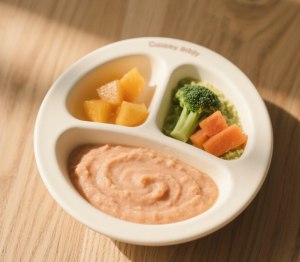
🍼 Introduction: From Milk to Meals
Introducing solid foods is one of the biggest milestones in your baby’s first year. It’s a time filled with adorable messes, suspicious looks at green mush, and a million questions: What do I feed them first? When should I start? What if they don’t like it? This guide has you covered.
We’ll explore when and how to start solids, what foods to offer first, allergy safety, meal planning tips, and some real-talk about the messy, magical experience of watching your baby discover food for the first time.
👶 When to Start Solid Foods
Most babies are ready to start solid foods between 4 to 6 months of age. But age is just a number—look for developmental signs that your baby is ready:
Signs of Readiness:
- Sits up with minimal support
- Has good head and neck control
- Shows interest in what you’re eating
- No longer pushes food out with tongue (tongue-thrust reflex fades)
If your baby is hitting these milestones and your pediatrician agrees, it might be time for their first tiny taste!
🥜 Choosing Baby’s First Foods
Forget the old rule that you must start with rice cereal. There are many great first foods that are both nutritious and safe.

Best First Foods:
- Mashed avocado: Creamy texture + healthy fats
- Pureed sweet potato: Mild taste + vitamin A
- Iron-fortified baby cereal: Mix with breast milk or formula
- Steamed and mashed peas: Gentle introduction to veggies
- Pureed pear or banana: Naturally sweet and easy to digest
Start with one food at a time, and wait 3 days before introducing another. This helps spot any allergies or sensitivities.
🦥 Texture Progression: From Puree to Finger Foods
Babies go through several stages of texture learning:
Stage 1: Purees (4-6 months)
Smooth, single-ingredient foods with no lumps.
Stage 2: Lumpy Purees & Mashed Foods (6-8 months)
Introduce more texture. Add soft-cooked lentils, mashed potatoes, or blended meats.
Stage 3: Soft Finger Foods (8-10 months)
Try scrambled eggs, small pasta shapes, cooked carrots, ripe banana chunks, or toast strips.
By 12 months, most babies are eating a variety of family foods cut into safe, bite-sized pieces.
🌲 Allergens: When and How to Introduce
Introducing common allergens early (around 6 months) may reduce the risk of developing allergies.
Top 8 Allergens to Watch:
- Peanut
- Egg
- Milk (as ingredient, not drink)
- Soy
- Wheat
- Tree nuts
- Fish
- Shellfish
How to Introduce Allergens:
- Start with a tiny amount at home
- Observe baby for 2+ hours
- Watch for signs of allergy: rash, vomiting, swelling, trouble breathing
Always consult your pediatrician if your baby is at high risk for food allergies.
🪙 Safety First: What to Avoid
Foods to Hold Off On:
- Honey: Can cause botulism in babies under 1 year
- Cow’s milk (as a drink): Wait until 12 months
- Choking hazards: Whole grapes, popcorn, raw carrots, hard candy
- Added salt or sugar: Baby’s kidneys and tastebuds are still developing
And remember: always supervise your baby while eating!
👥 Responsive Feeding: Read Baby’s Cues
Responsive feeding means tuning in to your baby’s signals. It’s not about getting the biggest spoonful in their mouth—it’s about building a positive relationship with food.
Cues They’re Hungry:
- Leaning forward
- Opening mouth
- Reaching for food
Cues They’re Full:
- Turning head away
- Pushing food away
- Losing interest
💼 Sample Feeding Schedule (6-9 Months)
This schedule gives structure while leaving space for flexibility and baby’s appetite:
| Time | Feeding |
|---|---|
| 7:00 AM | Breast/formula |
| 8:00 AM | Solid breakfast (e.g., oatmeal + banana) |
| 11:00 AM | Breast/formula |
| 12:00 PM | Solid lunch (e.g., avocado + sweet potato) |
| 3:00 PM | Breast/formula |
| 5:30 PM | Solid dinner (e.g., peas + rice cereal) |
| 7:00 PM | Breast/formula before bed |
🎨 Making Mealtime Fun & Stress-Free
- Let baby touch, play, and even wear their food
- Offer food when baby is alert and not overly tired
- Use colorful spoons and plates for engagement
- Sit and eat together—babies learn by watching you








